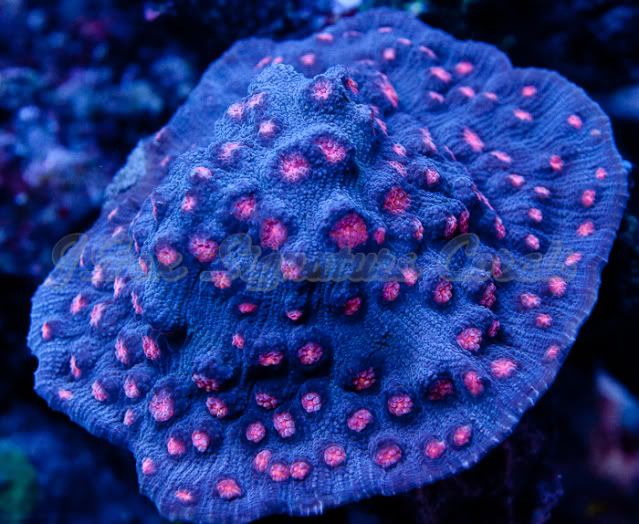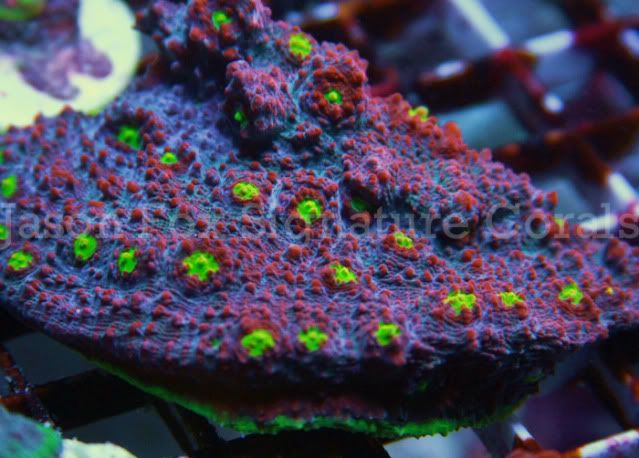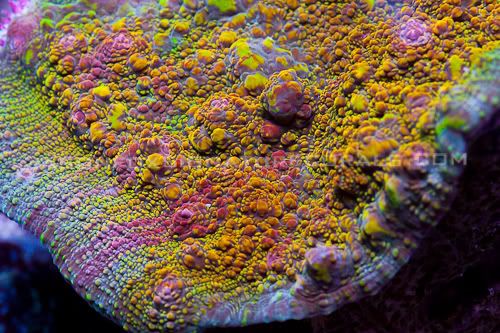The Echinophyllia genus is not only one of the easiest to keep of the Pectiniidae family, but the most colorful. In the wild they inhabit numerous habitats at various depths and water flow. Their adaptability to these multiple elements contributes to this being an easier coral to care for. In fact, if the edge of the coral is placed against any surface, like the glass of the aquarium, it will actually encrust onto it.
The shapes of the Echinophyllia species are generally an encrusting low rider formation of cups and folds. The middle of the coral can have significantly raised corallites that look like raised round, warty bumps. Their colors are endless, pretty much any combination, especially in the aquacultured varieties. The oral discs are usually a different solid color, contrasting with the colorfully mottled fleshy body.
Chalice Coral Echinophyllia aspera is an encrusting coral and has knobby centers. They form whorls, or circular formations, along with tiers or tall bump like protrusions. The outer perimeter of the coral, where growth takes place, is delicate. They can be mottled in a few or several colors, including green, red, brown, pink, purple, and blue with a green oral disc.
The Chalice Coral is easy to care for, but good water quality is very important for growth and health. Like all small polyp stony (SPS) corals, it gets much of its nutrition from the zooxanthellae that lives in it tissues, but can also be fed microplankton, cyclopeeze and other similar sized foods. However, it only feeds at night, when its feeder tentacles are extended.
The Echinophyllia species are slow growers, yet have been successfully propagated in captivity, helping to keep wild colonies in tact. This genus was often over looked in the past due to the drab looking colors they exhibited when first shipped to retailers. Those who did buy this drab lumpy coral found that over a few weeks they colored up beautifully.
Family: Pectiniidae
Species: Echinophyllia aspera
Distribution / Background
Echinophyllia Coral Information: The Echinophyllia genus was described by Klunzinger in 1879. There are approximately 30 nominal species. Of those, eight are true species with five of them being from Australia. Some common names these corals are know for are Plate Coral, Scroll Coral, Chalice Coral, and Flat Lettuce Coral. The Chalice coral Echinophyllia aspera was described by Ellis and Solander in 1788 and is known as the Chalice Coral.
The Echinophyllia genus have been successfully propagated in captivity. Aquacultured names these corals are know for are usually due to their color and the propagators choice, such as Mixed Berry Chalice, Crazy Orange Chalice, Pink Eyed Chalice Coral, Green Eyed Chalice Coral, and Green Echinophyllia.
Where Echinophyllia Corals Are Found: The Echinophyllia genus are found within the entire range of the Red Sea extending down the east coast of Africa, east to the coasts of Australia, and as far south as Lord Howe Island. From there their range extends all the way east to Tuamotu Islands, then north to the Line Islands. Then they extend west to the Marshall Islands and then in a north westerly direction to the southern tip of Japan. All the waters within that circumference, with the exception of a few bay areas, are where they are distributed
Echinophyllia Coral Habitat:The Echinophyllia genus habitat includes most reef environments, but they are mostly found on lower reef slopes, lagoons, and fringing reefs.
Status
The following species from the Echinophyllia genus are on the IUCN Red List of Endangered Species:
Chalice coral E. aspera: Least Concern (LC)
E. enchinata: Least Concern (LC)
E. nishihirae: Near Threatened (NT)
E. orpheensis: Least Concern (LC)
E. patula: Least Concern (LC)
Description
What do Echinophyllia Corals look like: The Echinophyllia genus are generally an encrusting low rider formation of cups and folds. The middle of the coral can have significantly raised corallites that look like raised round, warty bumps. The flat middle, where the oral disc is located, is a raised area 1/2" (1.27 cm) or larger. Some are less dramatically structured with little whorls and slight bumps. The ends or outer perimeter of the coral are delicate.
The colors of the Echinophyllia genus are pretty much any combination, especially the aquacultured varieties. The oral discs are usually a different and solid color from the colorfully mottled fleshy body.
The Chalice Coral E. aspera is encrusting and has knobby centers. It forms whorls, or circular formations, along with tiers or tall bump like protrusions. The corallites are raised and toothed, but not embedded. They can be mottled in a few or several colors, including green, red, brown, pink, purple, and blue with green oral discs.
Difficulty of Care
Echinophyllia Coral Care: The E. aspera s easy to care for. Good water quality is very important for growth and health.
Foods / Feeding
Echinophyllia Coral Feeding: In the wild, small polyp stony (SPS) corals have developed several feeding strategies. Through a symbiotic relationship with a marine algae, known as zooxanthellae, they receive the majority of their nutrients. They also capture planktonic organisms, food particles from the water column, and can absorb dissolved organic matter.
In captivity, they do well in well-feed reef tanks. Like other SPS, they use their zooxanthellae for nutrition. it does not require direct feeding, but can be fed microplankton, cyclopeeze and other similar sized foods at night when feeder tentacles are present.
Aquarium Care
Pristine tank conditions are typically needed to keep all SPS corals. Keep the nitrate levels low, and maintaining calcium and alkalinity levels. Typically you can do water changes of 20% a month, 10% biweekly or 5% weekly. It has been noted that 5% weekly water changes replenish many of the needed additives. With higher concentrations of coral with calcareous skeletons, there may be a need put in additional additives to maintain proper levels for good growth. When keeping this coral, using carbon may prove useful and beneficial for the other corals. Additions of trace elements are also suggested.
The following water supplements are suggested for Echinophyllia species:
Calcium: 380 to 430 ppm. If a small poly stony (SPS) coral does not have enough calcium, it will not grow. (Seachem makes a calcium additive that states 385 as sufficient)
Alkalinity: 3.2 TO 4.8 MEQ/L (8 to 11 dKh, 10 is recommended)
Phosphates: 0, zero. Phosphates are the worst of all and all corals hate them.
Magnesium: 1200 - 1350. (approx. 1272 ppm is suggested) Magnesium makes calcium available, so if your calcium is low, check your magnesium levels before adding any more calcium.
Strontium: 8 - 10
Aquarium Parameters
A well-feed live rock/reef environment is what is needed for your Chalice coral , along with some fish for organic matter production. A mature tank is recommended.
Quick Reference Chart
Lighting:
Water Flow:
Temperament:
The Echinophyllia corals keep their original color under various lighting intensities, including compact fluorescent bulbs. They should be kept under moderate to bright light with moderate water movement to keep them healthy. Make sure that no other corals can come in contact with your Echinophyllia. Echinophyllia spp. are aggressive, and will sometimes extend sweeper tentacles that will sting nearby corals.
Minimum Tank Size / Length: 29 gallons (115 L) and up, depending on size.
Marine Lighting: Moderate to bright
Temperature: 74° - 82° F (23° - 27° C)
Salinity / Specific Gravity: 1.023 - 1.025
Water Movement: Moderate, enough to keep debris off
Water Region: All areas of the aquarium
Compatibility and Social Behaviors
The Echinophyllia genus are aggressive, forming stinging sweeper tentacles on some nights. The Chalice Coral needs to be kept away from other corals as it will sting any that it can reach. These corals can have a a sweeper tentacle length of up to one foot. Although the sweepers do not come out every night, be sure to take their reach into consideration when placing them.
Sex - Sexual differences
Unknown
Breeding and Reproduction
The small polyp stony (SPS) corals are male and female and can reproduce both sexually and asexually. In the wild they reproduce sexually by releasing eggs and sperm at the same time, resulting in a fertilized egg which then forms into a free-swimming planula larva. Eventually the planula larvae settles onto the substrate, becoming plankters. This then forms a tiny polyp which begins to excrete calcium carbonate and develops into a coral. Planula larvae are extremely vulnerable to predation, and very few survive. Echinophyllias reproduce asexually as well. In the wild Echinophyllias spread from breakage due to storms and fragmentation.
Propagation is very easy for Echinophyllia corals. The frag should be taken from an already healthy and settled colony. It is done with very clean cuts in the skeleton of the mother colony with a fresh razor blade. Cut straight in from the outer edge about 1", remove and at 1" away from the original cut, cut parallel in about 1" and snap off the section in-between each cut. Make sure to mount the frag horizontally and put in a clean frag tank to recover. Wearing protective gloves is important so as to not form a reaction to them.
Potential Problems
The Echinophyllia spp. are generally disease resistant, but do not tolerate poor water conditions very well. They can get the same illnesses that any other small polyp stony (SPS) coral can get under poor conditions. Protozoan brown jelly infections are common in this group. You want to prevent this infection from spreading. Siphon off any "jelly" before lifting the coral out of the tank, then use a baggy to collect the coral, keeping the infection contained. Put it into an isolation tank that is separate from the main tank.
Here are a few treatments for brown jelly:
A 3 minute freshwater dip, with the water being the same temperature and PH as the sea water the coral is in.
Iodine baths using one drop of Lugol's iodine per 5 gallons of sea water may help, but the bath needs to last around 15 minutes and aeration needs to be high. Some have applied iodine directly to the affected area before putting in the iodine bath.
Use tetracycline in sea water baths that last up to 5 hours a day. The coral must be put in fresh sea water in-between each treatment and treatment water must be discarded.
Availability
Echinophyllia Corals for Sale: The Chalice coral E. aspera is very easy to find at pet shops and on line. Online they can run from about $30.00 to $300.000 USD depending on size and/or color.
References
Animal-World References: Marine and Reef
Eric Borneman, Aquarium Corals : Selection, Husbandry, and Natural History , TFH Publications, 2001
Anthony Calfo, Book of Coral Propagation, Volume 1 Edition 2: Reef Gardening for Aquarists, Reading Trees; 2nd edition, 2007
J.E.N. Veron, Corals of Australia and the Indo-Pacific , University of Hawaii Press; 2 Rev Ed edition, 1993
Charles J. DeVito, The Easily Over-looked Echinophyllia, Advanced Aquarist's Online Magazine, Copyright 2003
Bob Goemans, Plate Coral, Scroll Coral, Chalice Coral, Flat Lettuce Coral, Echinophyllia aspera, Animal Library, Saltwatercorner.com
Author: Carrie McBirney, Clarice Brough, CRS





